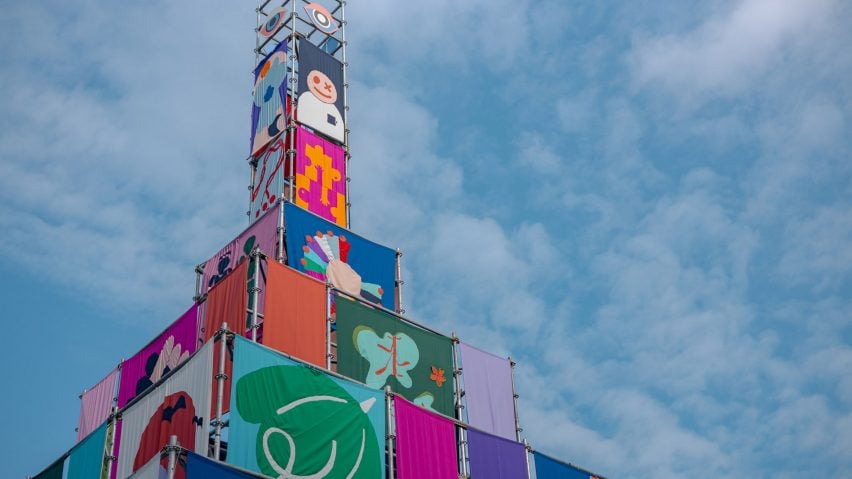A stepped six-tiered pyramid dominated the main Ketelhuisplein square at Dutch Design Week this year, wrapped in colourful flags offering 80 different symbols for peace.
Each flag for the Temple of Peace was created by a design graduate together with a current or former refugee – hailing from Syria, Ukraine, Russia, Yemen, Palestine and beyond.
The project was initiated by Ingeborg Bloem and Stefany Rietkerk, founders of the non-profit Peace Seekers Foundation, to find new emblems for peace in this era when there are now more violent conflicts than at any time since the second world war.
"We need new symbols and stories for peace because the symbols that we're using now are all more than 60 years old," Bloem said, referencing iconic motifs like the white dove and Gerald Holtom's three-pronged peace sign.
The Temple of Peace consists of a scaffold structure designed by Bloem based on the many-tiered Buddhist pagodas of Nepal, while the banners resemble colourful prayer flags.
The textile hangings themselves were each designed in an hour and made in a day via workshops bringing together refugees and students recruited from Dutch art and design schools, in a process that Bloem likens to speed dating.
"When the music stopped, they had to work with the person next to them," she told Dezeen. "It was really nice because students never see asylum seekers and asylum seekers never see students."
"So in the beginning they came in a little bit shy. But then when they were making the flags, all the stories came out."
Ahmad Shawesh, a Palestinian born in exile in Egypt, worked with Utrecht School of the Arts graduate Nande Overtoom to create a flag emblazoned with the outline of a key.
This is a symbol of Palestinians' right of return – the universally recognised human right that refugees have to return to the land of their origin or citizenship – and the key also carries a more personal significance for him.
"My grandfather gave me a key for our house in Palestine and he told me: keep it with you, so one day we will come back and you will feel peace," said Shawesh, who studied architecture before fleeing Syria and relished the opportunity to put his design skills to use.
At the centre of the key is an abstract dancing figure in white, chosen by Shawesh's wife Samia Abbas to represent freedom. Dancers also feature in a flag made by a team of Kurdish asylum seekers.
"For them, a symbol of peace is when Kurdish people dance together hand in hand – because they never dance alone," explained Niloofar Azimian, an Iranian documentary filmmaker and program creator for the Refugee Company, who recruited participants for the project.
Nafeza Hasmus from Syria added a wing to her design to represent freedom and Fatima Shahjoob attached strips of fabric that billow in the wind like strands of hair, paying homage to the women fighting against compulsory veiling laws in her home of Iran.
Another flag features an olive branch – a historic symbol of peace and Palestinian resilience chosen by Kuwait-born Palestinian Khaled Zeedan, who studied in Ukraine before fleeing Russia's invasion.
The branch was set against a baby blue backdrop and combined with a sprig of lavender, which to Dutch graphic designer Sadie Nadine van Breemen evoked memories of childhood.
"That was one point we agreed on because my mum, too, used a lot of lavender oil when I was a child," Zeedan said.
Art student Lorena Battistella worked with a married couple from Egypt to create a flag that hearkens back to the historical flag of the Kingdom of Egypt, featuring three white stars that represent Islam, Christianity and Judaism coexisting in peace.
Fashion design student Matin Moini, who says he had to flee Iran due to his involvement in the protest movement, worked together with ArtEZ art student Arya Rambod to create two different flags.
One features two unisex human figures of different heights to illustrate the drive for equity over equality, while the other uses concentric squares of black and red as a critical commentary on the amount of death and bloodshed entailed in the pursuit of peace.
"What I really liked about this whole project wasn't necessarily the actual piece we made – although I like that, too," Rambod said.
"But it was the social aspect of it that was interesting, talking about what peace actually is and hearing other people's ideas about how we can actually create a world where we accept each other."
At the centre of the pyramid, a small greenhouse hosted performances and workshops throughout Dutch Design Week, encouraging attendees to imagine their own symbols for peace.
Peace Seekers hopes to bring the concept installation design and music festivals all over Europe, working with locals to create a new set of flags every time.
Dutch Design Week, which concluded on Sunday, showcased projects by more than 2,600 designers across some 120 venues.
Other highlights included an inflatable toilet, a 3D printing filament made from waste date pits and a pop-up dining room celebrating the tenth birthday of the ethical design brand Social Label, which creates work opportunities for makers with disabilities.
The photography is by Sem Hovingh.
Dutch Design Week took place from 19 to 27 October 2024 in Eindhoven. See Dezeen Events Guide for more architecture and design events around the world.

